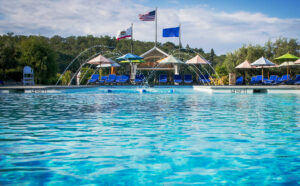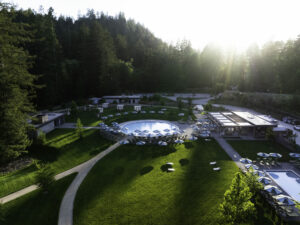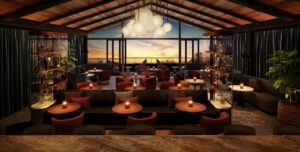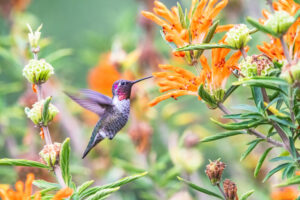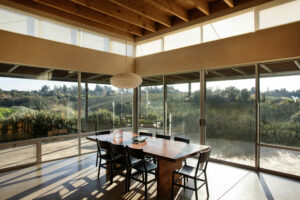When Fred and Barbara White Perry purchased 4 acres that were once part of the historic Buena Vista Winery, established in 1857, they felt a huge responsibility to honor the land. Located inside the Buena Vista gate and with a view through the trees to Bartholomew Park Winery, they can imagine Agoston Haraszthy, the original owner of both wineries and vineyards, still wandering their rows of Zinfandel.
In 1996, the couple had been living for 10 years in a two story home Barbara designed on Sonoma Mountain, where they enjoyed riding their horses. They’d tired of living in the hills and were searching for flat land closer to the heart of things near Sonoma Plaza, where they could build a home with no stairs. Buena Vista’s ownership was transitioning yet again at the time, and when they heard a small piece of the estate was for sale, with vines planted by acclaimed viticulturist Anne Moller-Racke in the early 1980s, they snatched it.
Barbara, an artist and architectural designer, began rendering the plans for their new home by hand, starting out by sitting for hours in the rain, diagramming the natural flow of water on their future home site. She planned the home to the minutest detail, building an architectural model — a step usually reserved for large commercial properties. Even the home’s color palette was decided at the model phase (the exterior stucco is painted the exact color of a rock found on the property). Barbara’s blueprints were stamped with the county’s permit approval on Valentine’s Day 1997, a sign that this home they now cherish would become part of their ongoing love story.
The couple spent hours siting the home’s front door, standing on ladders and taking photos, eventually deciding on the perfect view. A 12-foot-deep veranda with pillars runs the width of the house, a subtle historical reference to Haraszthy’s original villa.
Barbara’s second design inspiration came from an old, wooden, three-gabled farmhouse on Arnold Drive. She had long admired the slowly deteriorating structure and photographed it in 1984. Their home now has three gables, just like the farmhouse did until it was bulldozed in 2001.
The farmhouse was also important to Barbara because it was one of the sparks that led to her publishing her book, “Drawing Sonoma,” which was released in late 2015 and is now in its second printing. The book is a collection of 45 of her ink and vine charcoal drawings of historic and unique properties in Sonoma Valley. The three-gabled farmhouse appears in the section titled, “Gone But Not Forgotten,” where iconic structures no longer standing are captured.
When building a home, most people consider how many heads on pillows they want to accommodate, but for Barbara and Fred, it was all about art on walls. Longtime collectors, particularly of notable Sonoma artists, their goal was to make the interior perfect for showing art. Barbara plotted all the windows so that there was room in between for canvases, and integrated lighting in the 9-foot ceilings to shine at the perfect angle to illuminate paintings. At the center of the residence is a long gallery wall with ample room for the 11 paintings that hang there.
Above the living room fireplace is a Dennis Ziemienski painting, the largest piece in their collection. They also have two Keith Wicks oils, one depicting Spain Street West and the other The Corner Store on the plaza, both purchased at Sonoma’s Plein Air Festival in 2009. There are three Brigitte McReynolds pastels, and commissioned Cynthia Hipkiss clay sculptures of Fred and Barbara riding horses while sipping sparkling wine, with a little sign that reads, “Here’s to 40 Years of Happy Trails.” The “40” is a Post-it, as Barbara updates the number on each wedding anniversary.
In the entry hall are three Jim Callahan bronze sculptures, “Golden Girl,” “Unbridled” and “Sisyphus,” a surprise gift from Fred to Barbara. He placed it on a ledge near the front door and waited until she noticed it. She was thrilled when it caught her eye a few days later.
They also buy art on their vacations, with many pieces acquired at galleries in Carmel. They see something they like, then discuss the possible purchase at dinner over a glass of wine. “We joke later about whether it was a one-glass or two glass decision,” Barbara said. Their home has a trussed roof, which means fewer weight bearing walls are required, making it open and airy. The clean lines encourage a certain ease and sense of calm. Simple, well-designed furniture seems to fade away so the art can reign. The doorways are 3 feet wide with a flat saddle for ease of movement, and the flooring throughout is 12-inch, off-white porcelain tile that has a sheen, which Barbara said makes it easy to keep pristine. She was the general contractor for the project, and the goal in the material choices she made was to keep the home low-maintenance.
Behind the 2,900-square-foot, three-bedroom home (a master suite, guest bedroom and an office for Fred, an expert in cyber security) is Barbara’s artist studio, where she paints almost every day. While the White Perrys collect other Sonoma artists, including Claudia Wager and Brennie Bracket, there are many who collect Barbara’s work. She has been painting since she was a young girl in rural Illinois, studied at the Chicago Art Institute, and was honored as Sonoma’s “Treasure Artist” in 2015.
There is a garden patio between the home and the studio, and an additional outdoor eating area off the dining room, giving two alfresco options no matter which way the wind is blowing. Three acres of vineyards completely surround the home.
Fred and Barbara are philanthropically inclined, and have held many nonprofit fundraisers on their property, often with Fred preparing all the food. They particularly enjoy contributing to Sonoma’s Pets Lifeline, where they found their adorable dog, Benny, a Jack Russell-West Highland white terrier mix. They have a long association with the Sonoma League for Historic Preservation, and are proud that their property won the League’s Preservation Award in 1999 for “new construction compatible with and sensitive to existing historic structures or sites.”
As their home is just a stroll away from Buena Vista’s stone press house, built by Haraszthy in 1863, it’s indeed quite an accomplishment.



